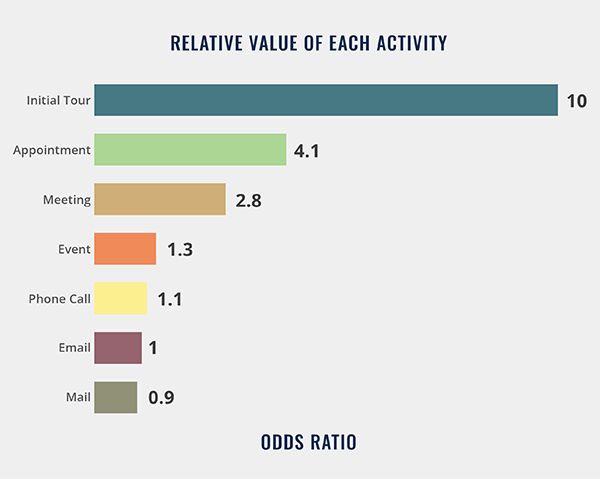Senior living communities typically collect hundreds of data points on each prospect throughout the sales process. This data is used by sales counselors to inform their strategy and interactions with the prospect. Once the sales process is complete, all of this valuable data sits unused in the customer relationship management system (CRM), benefitting nobody.
Alternatively, you can use your historical data to uncover new insights and guide sales strategies. Rather than relying on anecdotal evidence and gut feelings, your own data can give you a clear picture of which factors really matter in the sales process. A few examples of the questions you can answer are:
- How many phone calls does it take, on average, for a prospect to convert?
- Which market sources have the highest conversion rate?
- How many days does it typically take to go from initial inquiry to deposit?
- How frequently should we reach out to a prospect if we haven’t heard from him or her?
- What is the relative value of each interaction? (For example, are calls more impactful than emails?)
Solutions
At WildFig, we work with our senior living partners to develop data-driven prospect scoring solutions to help answer these questions. In simple terms, all of this data is passed through a statistical model that weighs things such as the interactions with a prospect, their market source, their demographic information, and whether or not they become a resident. This outputs an effective, unbiased picture of how important each of the factors is in securing a conversion. Each version is a custom to each organization, so the insights are unique and tailored to each community.

Looking Ahead
Once you begin using data to get a clear look at past performance, the next step is to incorporate the findings into your sales process and impact future behavior. For example, if phone calls tend to have a high impact for your community, it may be smart to take the time to reach out and initiate that conversation rather than sending a text message or email. Further, if you find that getting a prospect to visit your campus makes them 8x more likely to choose your community, it would be prudent to evolve your sales process to encourage campus visits early and often. As behaviors change, the data will also change, which will in turn will require behaviors to change again! This continuous cycle of analyzing and adapting to what the data shows is how organizations can stay ahead of the curve. While this may sound daunting from a management perspective, the model will continuously update as new information comes in, and will show you what is most important.
For more information on the benefits of a data-driven prospect scoring solution and how to put your own data to use, please contact Dr. Kevin Purcell, Chief Data Scientist of WildFig, at kpurcell@wildfigdata.com.
